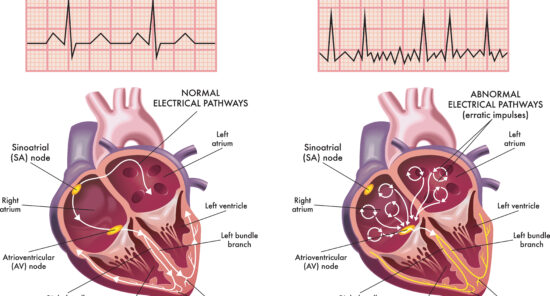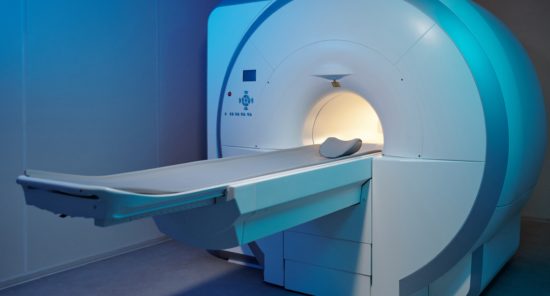Credit: Original article published here.According to a study, published in Frontiers in Cardiovascular Medicine, the functions of aging that increase risks of atrial fibrillation development and progression are not fully understood. Researchers performed a weighted gene co-expression network analysis to seek key modules and gene hubs associated with aging-related atrial fibrillation. The study’s lead author, Chuanbin Liu, reported the team identified 9 hub genes that may play central roles in the mechanisms of aging-related atrial fibrillation: PTGDS, COLQ, ASTN2, VASH1, RCAN1, AMIGO2, RBP1, MFAP4, and ALDH1A1. Of note, 6 of these genes were associated with atrial fibrillation for the first time in this study. Novel Genes of Interest in Aging-Related Atrial Fibrillation The authors conducted the weighted gene co-expression network analysis using the Gene Expression Omnibus atrial fibrillation dataset GSE2240, which included cardiac patients with atrial fibrillation or sinus rhythm. Researchers examined hub genes in clinical samples and verified their findings with Gene Ontology and Kyoto Encyclopedia of Genes and Genomes enrichment analyses. Reportedly, the green and pink modules were the most critical that had an association with atrial fibrillation. Within those, investigators flagged 9 hub genes with potentially significant roles in atrial fibrillation pathophysiology among elderly patients. Additionally, 7
Credit: Original article published here.According to a study, obstructive sleep apnea (OSA) is associated with increased incidences of atrial fibrillation and other adverse cardiovascular events. Researchers, led by Nitesh Sood, compared rivaroxaban and warfarin in patients with nonvalvular atrial fibrillation (NVAF) and concomitant OSA. The investigators found rivaroxaban showed a similar risk for stroke or systemic embolism (SSE) compared with warfarin; however, rivaroxaban was associated with fewer intra- and extracranial bleeding-related hospitalizations. The findings were published in TH Open. Additional Benefits With Rivaroxaban Versus Warfarin Researchers analyzed electronic health records total of 21940 patients on rivaroxaban and 38213 on warfarin from November 2010 to December 2021. All patients had NVAF and OSA and initiated first-time rivaroxaban or warfarin at enrollment. The primary end points were incidence of SSE and bleeding-related hospitalization. Rivaroxaban had a similar risk of SSE compared with warfarin (hazard ratio [HR], 0.92; 95% CI, 0.82-1.03) among patients with NVAF and OSA. Notably, rivaroxaban provided additional benefits with reductions in any bleeding-related hospitalizations (HR, 0.85; 95% CI, 0.78-0.92), intracranial bleeding (HR, 0.76; 95% CI, 0.62-0.94), and extracranial bleeding (HR, 0.89; 95% CI, 0.81-0.97). Authors conducted a sensitivity analysis on just patients with prespecified CHA2DS2VASc scores and estimated reductions
Credit: Original article published here.In a study, published in JAMA Cardiology, researchers compared an augmented double wide-area circumferential ablation (WACA) with the standard single WACA method for preventing atrial arrhythmia recurrences in patients with paroxysmal atrial fibrillation. However, according to the study’s lead author, Girish Nair, additional ablation for paroxysmal atrial fibrillation with a double lesion strategy did not improve the proportion of patients who achieved freedom from recurrent atrial arrhythmias when compared with the standard ablation. Augmented Ablation for Atrial Fibrillation Not Superior The multicenter, prospective, AWARE randomized controlled trial enrolled 398 patients with symptomatic paroxysmal atrial fibrillation undergoing catheter ablation across 10 university-affiliated centers in Canada between March 2015 and May 2017. Participants received pulmonary vein isolation with either a standard single WACA (n=195) or an augmented double WACA (n=203), followed by 42 days of ambulatory electrocardiography monitoring. The primary end point of the study was atrial arrhythmia recurrence from 91 to 365 days after the procedure. In total, 52 (26.7%) patients in the standard ablation arm and 50 (24.6%) in the augmented ablation arm had atrial arrhythmia recurrence at 1 year (risk ratio [RR], 0.92; 95% CI, 0.66-1.29; P=.64). Authors noted 20 (10.3%) and 15 (7.4%) patients needed to
Credit: Original article published here.VX1 is a novel AI support software designed to assist cardiac electrophysiologists performing catheter ablation procedures in patients with atrial fibrillation by identifying areas of abnormal signals during the mapping phase. The platform is being evaluated in the TAILORED-AF trial. Transcript Theophile Mohr-Durdez, CEO of Volta Medical, spoke with DocWire about his company’s mission and VX1, their AI support tool for cardiac electrophysiologists. DW: What is the background of Volta Medical? TM: Volta Medical is a company that I co-founded with 3 physicians, 3 cardiac electrophysiologist in 2016, and we are developing AI solutions to guide cardiac electrophysiologist while they are ablating patients with cardiac arrhythmias. And we co-founded this company to develop an initial product that is now C-marked and FDA-cleared, which is named VX1, that is aimed at guiding cardiac electrophysiologist while they’re ablating patients with atrial fibrillation. DW: What motivated the creation of an AI solution for AF ablation? TM: Initially, my 3 physician co-founders, I am myself a data scientist, and so when we met, they had developed a very specific expertise, a clinical expertise in identifying abnormal electrograms, abnormal signals, during AF ablation procedures. And these electrograms helped them to target
Credit: Original article published here.In a recent meta-analysis published in Current Cardiology Reviews, researchers explored whether stages of fibrosis observed on late gadolinium enhancement magnetic resonance imaging (LGE-MRI) could predict atrial fibrillation recurrence after catheter ablation. According to the study’s lead author, Manjari Rani Regmi, there was a strong association between left atrial fibrosis on LGE-MRI and atrial fibrillation recurrence post-catheter ablation. The authors’ systematic literature review identified 9 studies containing 1787 patients who underwent LGE-MRI to evaluate atrial fibrosis prior to undergoing catheter ablation for atrial fibrillation. Atrial Fibrosis Predicts Atrial Fibrillation Recurrence After Ablation The study’s primary comparisons included stage IV atrial fibrosis versus stage I, combined stages III and IV versus stages I and II, and stage IV versus combined stages I, II, and III. The authors used random-effects models to calculated pooled odds ratios (ORs) using the DerSimonian and Laird method. Researchers found patients with stage IV atrial fibrosis after ablation had a higher rate of atrial fibrillation recurrence compared with those with stage I atrial fibrosis (OR, 9.54; 95% CI, 3.81-28.89; P<.00001). In addition, the investigators noted patients with combined stages III and IV atrial fibrosis demonstrated significantly higher atrial fibrillation recurrence than patients with
Credit: Original article published here.In a randomized controlled trial, published in JAMA, researchers compared pulmonary vein isolation (PVI) with posterior wall isolation (PWI) versus PVI alone in patients with persistent atrial fibrillation undergoing first-time catheter ablation. Based on their findings, they concluded the combination of PVI and PWI did not significantly improve atrial arrhythmia recurrence after 1 year compared with PVI alone in their study’s population. The multicenter randomized controlled trial was conducted from July 2018 to March 2021 in 11 centers across Australia, Canada, and the UK. In the trial, 168 patients underwent wide antral PVI alone and 170 underwent wide antral PVI followed by PWI comprised of linear ablation at the roof and floor. Participants were followed for 1 year, ending in March 2022. PVI With or Without PWI in Atrial Fibrillation The primary end point after was freedom from documented atrial arrhythmia lasting more than 30 seconds at 12 months with 1 ablation procedure and without the use of antiarrhythmic medication. Additional end points included freedom from atrial arrhythmias and symptomatic atrial fibrillation after multiple ablation procedure, with or without antiarrhythmic medication, as well as atrial fibrillation burden, procedural outcomes, and complications. The initial cohort included 338







